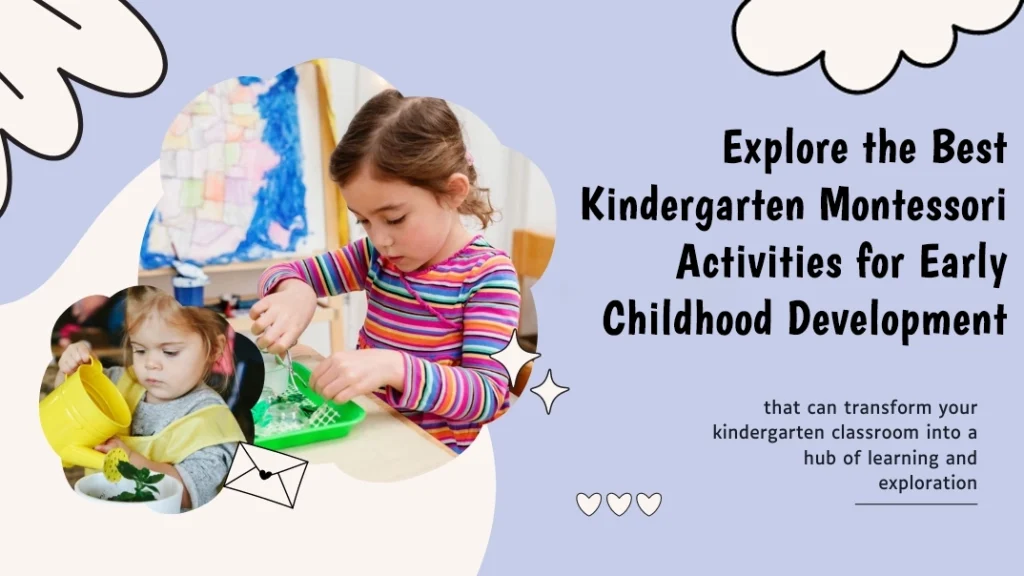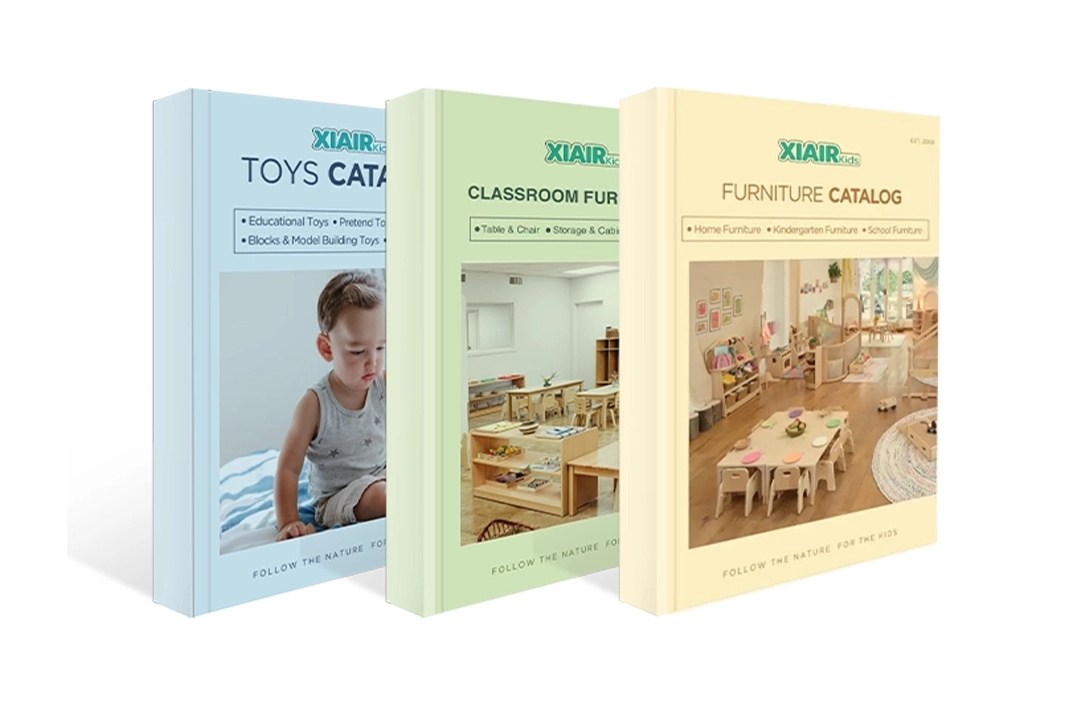Are you looking to enhance your kindergarten Montessori activities? Ensuring that children engage in meaningful and educational tasks can be challenging. Montessori activities provide an excellent solution, fostering both independence and cognitive development. These activities are designed to meet the developmental needs of young children, making learning both enjoyable and effective.
Offering engaging and educational activities is crucial in the early years of education. Montessori activities excel in this area by promoting hands-on learning and encouraging children to explore their environment. Integrating these activities into your kindergarten classroom can create a dynamic learning atmosphere supporting essential skills growth.
Kindergarten Montessori activities that can transform your kindergarten classroom into a hub of learning and exploration. These activities focus on practical life skills, sensory experiences, and cognitive development, ensuring a well-rounded approach to early childhood education.
Montessori activities are designed to help children develop fine motor skills, hand-eye coordination, and critical thinking abilities. They provide a structured yet flexible framework that allows children to learn independently. This child-centered approach fosters a love for learning and helps build confidence in children.
Curious to learn more? Keep reading to discover these impactful activities and see how they can benefit your kindergarten classroom. By incorporating these Montessori activities, you can create an engaging and educational environment that nurtures the growth and development of each child.
Incorporating Montessori activities into your kindergarten curriculum can profoundly impact children’s learning experiences. These activities are not just about keeping children busy but about providing meaningful, purposeful tasks that contribute to their overall development. From practical life skills like pouring and scooping to sensory activities like gluing paper, each activity is designed to support children’s growth.
By embracing Montessori activities, you can help children develop a strong foundation in various skills, preparing them for future academic success. These activities offer countless benefits, Whether through hands-on learning, sensory exploration, or practical life exercises. So, let’s dive into these 13 essential kindergarten Montessori activities and explore how they can transform your kindergarten classroom into a vibrant learning environment.
Montessori Activities for Kids: Ultimate Guide to Practical, Sensory, and Creative Learning
Montessori activities are transformative tools that nurture independence, creativity, and cognitive development. Grounded in Maria Montessori’s philosophy, these activities are designed for children from infancy to preschool and beyond, catering to various developmental stages and abilities.
Whether you’re looking for Montessori activities for 2-year-olds, creative Montessori art activities, or specialized Montessori practical life activities, this guide offers a comprehensive resource to enrich your child’s learning experience. Additionally, you’ll find insights on seasonal Montessori activities, like Montessori Christmas activities and Montessori Thanksgiving activities, as well as innovative ideas like homemade Montessori activities and Montessori activity books to explore at home.

What Are Montessori Activities and Why Are They Important?
Montessori activities are structured tasks designed to help children learn essential skills while fostering curiosity and independence. These activities engage children through hands-on exploration, tactile materials, and real-world applications.
Core Features of Montessori Activities
- Practical Life Focus: Activities like spooning and folding develop fine motor skills and responsibility.
- Sensory Development: Tasks like sensorial activities. The Montessori method engages the five senses to refine perception.
- Cognitive Exploration: Activities such as sorting and puzzle-solving build critical thinking and problem-solving skills.
The beauty of Montessori activities lies in their adaptability; they can be tailored to specific ages, interests, or abilities. For example, Montessori toddler activities focus on sensory and motor skill development, while Montessori preschool activities introduce concepts like math, language, and science.
Montessori Activities for Different Age Groups: Tailored to Developmental Needs
Montessori activities are designed to support children’s natural developmental stages. These activities focus on fostering independence, creativity, problem-solving, and fine motor skills, all of which vary depending on the age group. The Montessori method adapts to the needs of children from infancy to the early years of school. Below is a comprehensive guide that outlines activities for different age groups, showcasing how they promote growth in areas such as motor skills, cognitive development, and social-emotional learning.
Montessori Activities for Infants (0-12 Months)
For infants, Montessori activities focus on sensory exploration and establishing early motor skills. At this stage, babies explore their environment through their senses: touch, sight, and sound. The activities are simple yet impactful, promoting the development of basic reflexes and helping babies engage with the world around them.
| Activity Type | Description |
|---|---|
| Tummy Time | Strengthens the neck and shoulder muscles, preparing for crawling. |
| Sensory Baskets | Safe items like textured fabrics, rattles, and colorful objects stimulate vision and tactile senses. |
| Water Play | Supervised shallow water play using small toys to encourage hand-eye coordination. |
| Stacking Toys (9-12 months) | Introduce simple stacking toys that promote fine motor skills and hand-eye coordination. |
| Cause-and-Effect Games (12 months) | Simple activities where babies can learn cause and effect, such as pressing buttons or dropping objects. |
As babies grow older, activities become slightly more complex. At 9 months, activities like stacking soft blocks or sorting large, colorful shapes help improve coordination. By 12 months, babies can start engaging in basic cause-and-effect games, such as pressing buttons to make a sound, which helps with their cognitive and sensory development.
How These Activities Support Development:
- Sensory Development: Activities like sensory baskets and water play provide babies with a chance to explore textures, sounds, and sights, which are crucial for sensory integration.
- Motor Development: Tummy time and stacking toys help build strength and coordination, which are key components for future physical milestones like crawling and walking.
Montessori Activities for Toddlers (1-3 Years)
As toddlers begin to walk and explore their world more actively, Montessori activities focus on fine motor skills, independence, and early cognitive development. Toddlers thrive on activities that build their self-confidence and refine their motor abilities. Montessori toddler activities introduce concepts like sorting, pouring, and simple problem-solving tasks that help enhance their cognitive and physical abilities.
| Activity Type | Description |
|---|---|
| Practical Life Skills | Tasks such as pouring, spooning, and transferring objects to improve hand-eye coordination and develop fine motor skills. |
| Fine Motor Activities | Lacing beads, stacking blocks, and using tongs or tweezers to manipulate small objects improve dexterity and concentration. |
| Sorting by Color/Size/Shape | Sorting different objects such as buttons, blocks, or coins by color, size, or shape enhances cognitive categorization skills. |
| Self-Care Activities | Brushing teeth, washing hands, and feeding themselves promote independence and responsibility. |
| Water Pouring and Transferring (2 years) | Pouring water from one container to another or transferring objects from one place to another enhances fine motor skills and concentration. |
At 2 years old, toddlers engage in more complex practical life activities like pouring or spooning, which help improve motor skills, focus, and hand-eye coordination. By the age of 3, they can begin tasks like sweeping or setting the table, which fosters independence and responsibility.
How These Activities Support Development:
- Motor Skill Development: Activities like using tongs, stacking blocks, and pouring water enhance fine motor skills, which are crucial for later academic tasks like writing.
- Cognitive Growth: Sorting objects by color, shape, or size helps toddlers develop their categorization abilities and lays the foundation for later academic learning.
- Independence: Self-care activities like brushing teeth and feeding themselves encourage self-sufficiency, boosting toddlers’ confidence and autonomy.
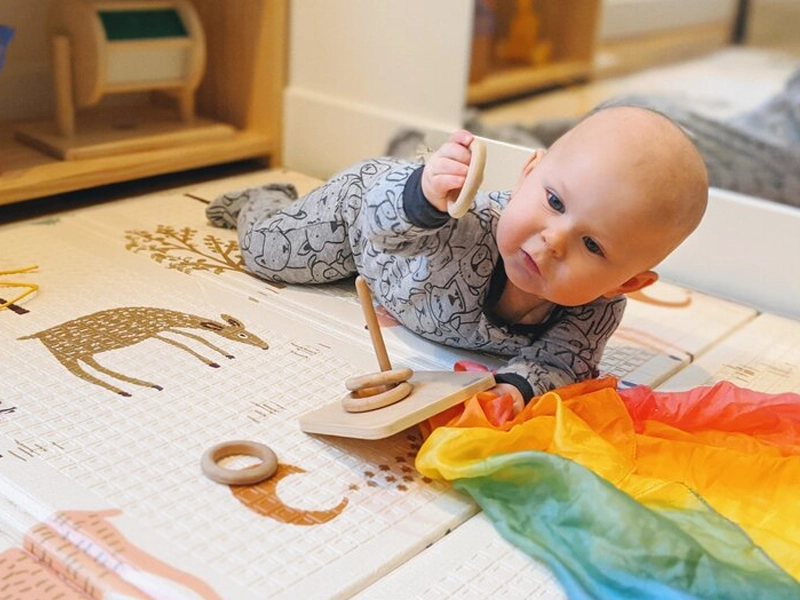
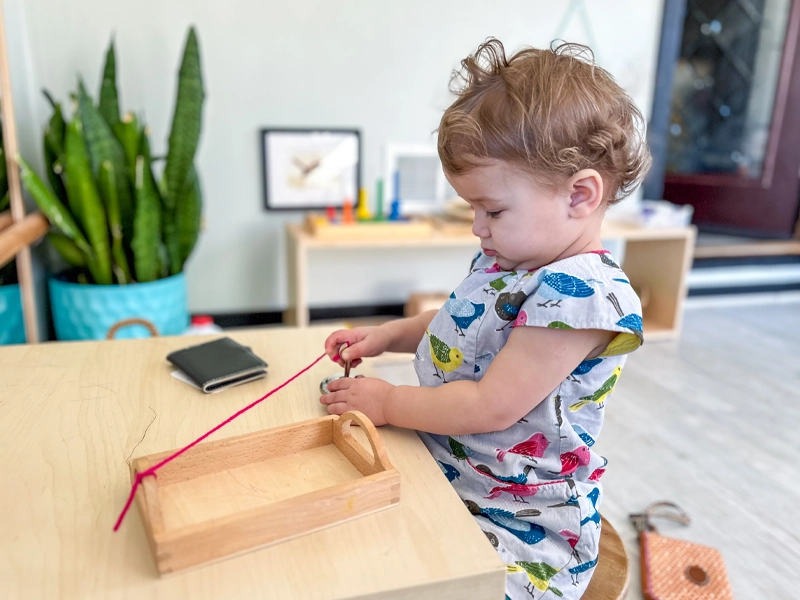
Montessori Activities for Preschoolers (3-5 Years)
Children’s cognitive, social, and emotional skills rapidly develop as they enter preschool. Montessori activities for preschoolers are designed to support these advancements while fostering creativity, problem-solving, and critical thinking. These more structured activities often involve learning experiences that integrate multiple developmental areas.
| Activity Type | Description |
|---|---|
| Montessori Math Activities (4 years) | Counting with manipulatives like beads or using objects to understand the concept of numbers, addition, and subtraction. |
| Montessori Language Activities | Phonics-based activities such as letter recognition, matching pictures with words, and pre-reading games help develop early literacy skills. |
| Montessori Art Activities | Activities such as painting, drawing, and crafting foster creativity and improve fine motor coordination. |
| Practical Life Activities | Tasks such as washing dishes, folding clothes, and buttoning shirts develop independence and responsibility while also enhancing fine motor skills. |
| Montessori Science Activities | Simple experiments or nature walks where children observe plant growth or animals help develop scientific thinking. |
At 4 years old, children engage in more complex Montessori math activities, such as sorting objects based on multiple attributes (size, color, shape). Preschoolers also begin to explore language through phonetic exercises and creative expression through art. These activities help prepare children for academic learning and self-reliance.
How These Activities Support Development:
- Cognitive and Academic Development: Montessori math and language activities lay the groundwork for future academic skills. Counting and phonics introduce basic concepts of numeracy and literacy.
- Creativity and Fine Motor Skills: Art activities encourage children to express themselves while improving their skills.
- Practical Life Skills: Preschoolers learn responsibility and independence by practicing daily tasks such as washing dishes or folding clothes.
Montessori Activities for Kindergarten-Aged Children (5-6 Years)
Kindergarten-aged children are ready for more complex tasks that require focused concentration, logical thinking, and detailed execution. Montessori activities for this age group introduce more advanced concepts in areas such as STEM (Science, Technology, Engineering, Math), language, and problem-solving.
| Activity Type | Description |
|---|---|
| STEM Activities | Simple science experiments, such as observing plant growth or experimenting with gravity, introduce children to basic scientific principles. |
| Montessori Sensorial Activities | Sorting materials by weight, texture, or temperature to further engage and refine the senses. |
| Montessori Activity Books | Puzzle books and games that challenge critical thinking and problem-solving skills, fostering intellectual growth. |
| Montessori Geometry and Math Activities | Identifying geometric shapes and exploring basic concepts of measurement, addition, and subtraction. |
At this stage, children delve into more detailed STEM activities, such as basic experiments and exploring the concept of gravity. Montessori geometry and math activities help them grasp complex concepts like shapes, measurements, and basic arithmetic.
How These Activities Support Development:
- Cognitive Development: STEM activities engage children in problem-solving and critical thinking, fostering a scientific mindset.
- Sensory Development: Montessori sensorial activities encourage children to refine their senses, which is essential for academic learning and everyday life.
- Intellectual Growth: Montessori activity books and geometry tasks help children develop logic, reasoning, and mathematical skills.
Montessori Activities for Older Children (7+ Years)
As children move into elementary, Montessori activities expand into more complex cognitive domains. These activities involve group learning, abstract thinking, and real-world problem-solving, which promote deeper intellectual engagement.
| Activity Type | Description |
|---|---|
| Montessori Peace Day Activities | Discussions about global peace, environmental conservation, and diversity through reading stories, making peace symbols, or participating in group activities. |
| Practical Life Skills for Older Children | More advanced tasks such as sewing, gardening, cooking, or organizing their school supplies foster independence and discipline. |
| Montessori Activities for Special Needs | Tailored activities for children with autism, ADHD, or other learning needs, focusing on sensory or motor skill development. |
Older children engage in activities that require critical thinking and collaboration, such as learning about peace and environmental conservation. These activities aim to cultivate a sense of responsibility, citizenship, and global awareness.
How These Activities Support Development:
Independence and Responsibility: Practical life activities help children build real-world skills like cooking, sewing, or organizing, which foster responsibility and independence. Ment of fine motor skills and practical life skills in children.
Abstract Thinking: Children at this age begin engaging in abstract thinking, problem-solving, and conceptual learning.
Social and Emotional Development: Group activities, such as discussing global peace, help develop empathy, communication skills, and social awareness.
Montessori activities are essential for fostering the development of children at every stage. From sensory exploration in infancy to more advanced cognitive and social learning in the later years, each activity is carefully designed to support a child’s natural growth trajectory. Following the Montessori method, children are encouraged to develop essential skills such as independence, creativity, problem-solving, and a love for learning, which will serve them well throughout their lives.



Don’t just dream it, design it! Let’s chat about your custom furniture needs!
Comprehensive Categories of Montessori Activities
| Category | Activity | Description |
|---|---|---|
| Practical Life Montessori Activities | Montessori Practical Life Activities List | Activities like pouring, spooning, buttoning, zipping, and folding to build motor control and independence. |
| Montessori Care of Self Activities | Activities such as brushing teeth, combing hair, and tying shoelaces to teach self-care and responsibility. | |
| Montessori Cleaning Activities | Tasks like washing windows, sweeping floors, and wiping tables to develop care for the environment. | |
| Montessori Shoe Polishing Activity | Introduces responsibility and precision through shoe polishing. | |
| Sensory Development Activities | 5 Senses Montessori Activities | Explore textures, sounds, and smells using natural materials to refine sensory perceptions. |
| Montessori Sorting Activities | Classify objects by texture, temperature, or color to enhance cognitive development. | |
| Sound Jars | Differentiate between high- and low-pitched sounds using jars filled with various materials. | |
| Montessori Smelling Activities | Use scented jars to help children recognize and identify fragrances like lavender or citrus. | |
| Creative Montessori Activities | Montessori Art Activities | Creative tasks such as gluing, painting, and folding paper into shapes to encourage artistic expression. |
| Montessori Timeline of Life Activities | Create visual timelines using drawings or crafts to teach sequencing and life events. | |
| Montessori Solar System Activities | Build models of planets using clay or paper to explore the solar system and basic astronomy concepts. |
Montessori Activities Based on Skill Development
Montessori activities can be grouped by the types of skills they target. Here’s how to approach skill development through Montessori principles.
Fine Motor Skills Activities
These activities focus on developing hand-eye coordination and agility, essential for writing, dressing, and eating tasks.
- Threading Beads: Children practice threading large wooden beads onto shoelaces, which improves hand-eye coordination and fine motor control.
- Tweezer Tasks: Using tweezers to pick up small objects helps children strengthen their pincer grasp.
- Nuts and Bolts: Screwing and unscrewing bolts helps children refine their hand strength and precision.
- Folding Cloth: Folding napkins or small towels teaches patience and fine motor accuracy.
Cognitive Development Activities
These activities engage children in problem-solving and encourage cognitive development, including logic, sequencing, and pattern recognition.
- Math with Beads: Use bead chains or rods to introduce children to numbers, essential addition, and subtraction.
- Color Mixing Stations: Set up stations to explore how different colors mix to form new shades, promoting scientific thinking.
- Science Experiments: Simple activities like observing plants’ growth or exploring water’s properties engage children in scientific thinking.
Gross Motor Skills Activities
These activities focus on strengthening large muscle groups and improving balance and coordination.
- Climbing and Balancing: Activities like climbing on a low structure or walking along a balance beam improve balance and muscle coordination.
- Running and Jumping: Simple games like relay races or jumping over obstacles help children develop gross motor control.
Social & Emotional Development Activities
Activities that encourage social skills and emotional understanding, including cooperation, empathy, and self-regulation.
- Role-Playing: Children play pretend play, such as house or community roles, to develop empathy and social skills.
- Cooperative Tasks: Activities like building a structure together or cleaning up after a project foster teamwork and responsibility.
Montessori Activities Based on Seasonal Themes
Seasonal Montessori activities are a great way to engage children with the changing environment and teach them about nature’s cycles. These activities integrate art, science, and sensory exploration elements, providing children with an immersive learning experience.
Fall Montessori Activities
In the fall, focus on the harvest season, the changing leaves, and preparing for winter.
- Leaf Rubbings: Children can create beautiful rubbings of colorful fall leaves using crayons and paper, learning about textures and patterns.
- Pumpkin Activities: Sorting pumpkins by size or color and scooping seeds out of pumpkins can enhance fine motor skills and sensory development.
- Autumn Sensory Play: Create sensory bins filled with acorns, leaves, and small pumpkins for tactile exploration.
Winter Montessori Activities
Winter provides opportunities to explore themes of cold, snow, and hibernation.
- Snowflake Making: Teach symmetry by having children cut out paper snowflakes.
- Ice Activities: Freeze small objects in ice and let children observe and discuss the melting process.
- Hibernation Studies: Teach children about animals that hibernate in the winter, such as bears and squirrels.
Spring Montessori Activities
Spring activities focus on growth, renewal, and the natural world coming to life.
- Planting Seeds: Teach children about the lifecycle of plants by planting seeds and observing their growth.
- Rain Cycle Exploration: Use simple science experiments to show how rain is formed and how it helps plants grow.
- Flower Exploration: Create a flower chart or engage in a nature walk to study different types of flowers.
Summer Montessori Activities
In summer, focus on outdoor exploration, water activities, and studying nature.
- Water Play: Set up a water table for children to explore pouring, scooping, and transferring water, which enhances fine motor skills.
- Gardening Projects: Children can plant flowers, herbs, or vegetables, learning about nature and responsibility.
- Outdoor Exploration: Engage children in observing insects, birds, and animals in their natural habitats.
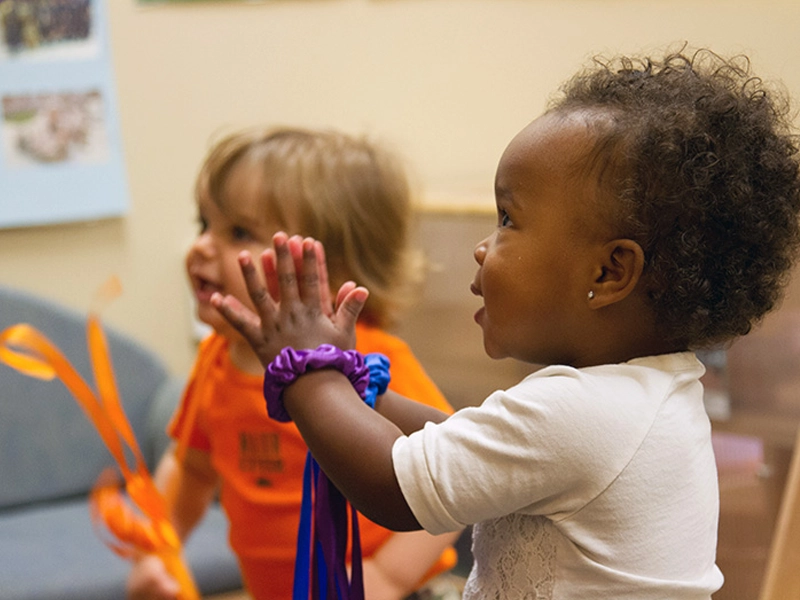
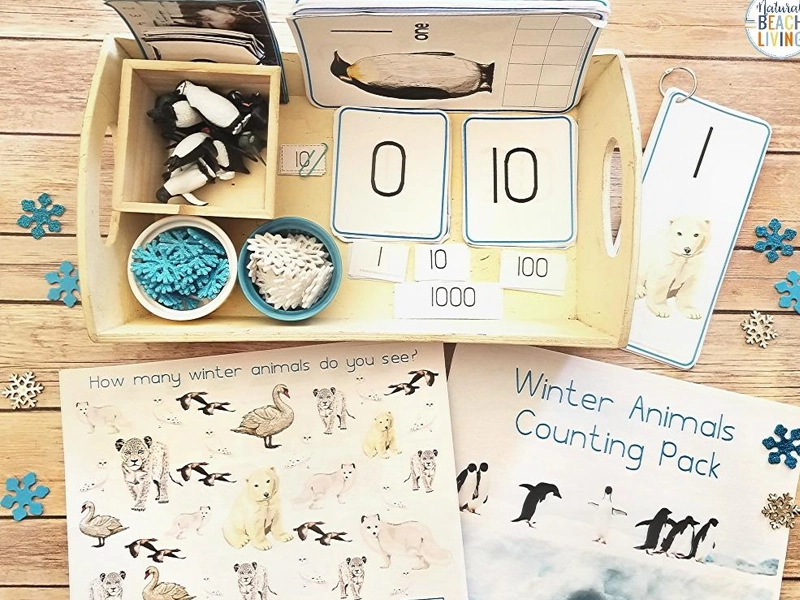
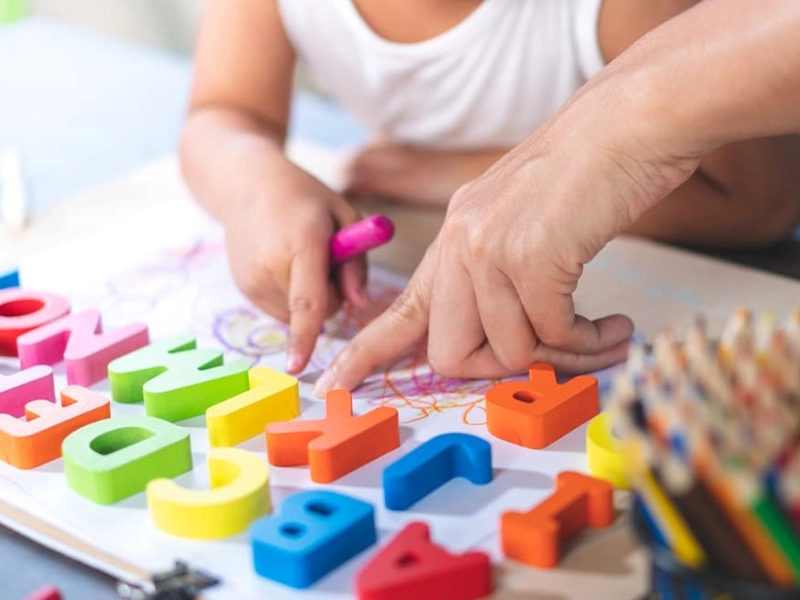
Montessori Activities Based on Activity Type
Different activity types in the Montessori method cater to various developmental needs and help children acquire specific life skills.
Hands-On Montessori Activities
These activities provide tactile experiences that help children learn through touch and exploration.
- DIY Montessori Sensory Bottles: Fill clear plastic bottles with colorful beads, glitter, or rice to engage children’s visual and auditory senses.
- Montessori DIY Activity Boards: Create boards with locks, buttons, and zippers for practical life skills like dressing and undressing.
- Montessori Sorting Trays: Use everyday objects like buttons, coins, or pebbles to teach categorization and fine motor control for sorting exercises.
STEM Montessori Activities
STEM activities combine science, technology, engineering, and math concepts, encouraging problem-solving, creativity, and hands-on learning.
- Science Experiments: Simple activities like making slime, growing crystals, or building volcanoes offer hands-on science experiences.
- Math Activities: Use number rods, beads, and counting blocks to teach math concepts like addition, subtraction, and multiplication.
- Engineering Challenges: Encourage children to build structures using blocks or simple materials, enhancing their understanding of engineering principles.
Montessori Art and Craft Activities
Art is essential to the Montessori method, helping children express their creativity and develop fine motor skills.
- Painting and Drawing: Allow children to freely explore colors and textures through painting or drawing, encouraging creativity.
- Montessori Weaving Activities: Teach basic weaving techniques using simple looms and colorful threads.
- Sewing and Knitting: For older children, introduce sewing with plastic needles or basic knitting, fostering patience and hand-eye coordination.
Practical Life Activities
Practical life activities are foundational in Montessori education. They help children develop independence, responsibility, and life skills.
- Pouring and Transferring: Practice pouring water between cups or transferring rice using spoons to enhance fine motor control.
- Cleaning Tasks: Let children help clean by wiping tables or sweeping floors, teaching responsibility, and contributing to household chores.
- Self-Care Activities: Teach children how to brush their teeth, wash their hands, or dress themselves, promoting self-sufficiency.
Montessori Activities Based on Materials
Montessori activities can also be categorized by the materials used, which help children connect with learning concepts tactilely.
Montessori Wooden Toy Activities
Using wooden toys in Montessori activities helps children develop coordination and understanding of shapes, colors, and sizes.
- Shape and Color Matching: Use wooden blocks or puzzles to help children recognize and match shapes and colors.
- Building Blocks: Encourage children to build structures using wooden blocks, developing their spatial awareness and creativity.
Montessori Nature-Based Activities
Nature-based activities use natural materials to engage children with the environment, enhancing their observational and sensory skills.
- Nature Walks: Take children on walks to observe plants, animals, and insects, helping them connect with the world around them.
- Nature Sorting: Sort leaves, stones, or flowers by size, color, or type to develop classification skills.
- Seed Planting: Use natural materials like soil, seeds, and pots to teach children about plant growth and natural cycles.
Teaching Responsibility with Window Washing Activities
Washing the window is another essential kindergarten Montessori activity that teaches children responsibility and the importance of cleanliness. This practical life activity involves simple tools like a spray bottle, a sponge, and a cloth. Children learn to spray water onto the window, wipe it clean with a sponge, and dry it with a cloth.
This activity helps develop gross motor skills as children reach and stretch to clean different window parts. It also teaches them the importance of maintaining a clean environment and caring for their surroundings. Washing the window provides immediate feedback, as children can immediately see the results of their efforts.
Children often find this activity enjoyable because it allows them to mimic real-life tasks they see adults performing. It gives them a sense of accomplishment and boosts their self-esteem. Additionally, washing the window can be a calming and focusing activity, helping to manage classroom dynamics.


Encouraging Creativity with Gluing Paper Activities
Gluing paper is a creative kindergarten Montessori activity that helps children develop fine motor skills and hand-eye coordination. This activity involves using glue sticks or liquid glue to attach pieces of paper. Children can create various art projects, such as collages, by gluing different shapes and colors of paper.
This activity encourages children to use their creativity and imagination. They learn to handle glue carefully, apply the right amount, and accurately stick pieces of paper together. The gluing paper also enhances children’s ability to plan and execute their ideas, a crucial skill for cognitive development.
In addition to developing fine motor skills, gluing paper helps children improve their concentration and patience. They must focus on their task and wait for the glue to dry before moving on to the next step. This activity also promotes problem-solving skills as children figure out how to arrange their pieces of paper to create their desired designs.


Building Independence with Dressing Frames Activities
Dressing frames are classic Montessori materials designed to teach children practical life skills related to dressing. These frames come with different fasteners like buttons, zippers, and buckles. Children practice opening and closing these fasteners, which helps them develop fine motor skills and hand strength.
Dressing frames provide a hands-on way for children to learn how to manage their clothing. They gain confidence as they master the skills needed to dress themselves independently. This activity teaches children patience and persistence as they work through the challenges of manipulating small fasteners.
Using dressing frames, children improve their hand-eye coordination and dexterity. These skills are essential for many other activities, such as writing and using utensils. Dressing frames also promote independence and self-care, critical aspects of Montessori education.
By incorporating these Montessori activities into your kindergarten curriculum, you can create a rich learning environment supporting essential skills development. These activities engage children and provide valuable opportunities for growth and learning.

Enhancing Dexterity with Button Frames Activities
Button frames are integral Montessori materials that help children learn to fasten buttons, which is an essential life skill. These frames typically have multiple buttons and buttonholes that children can practice with, simulating the task of buttoning clothes. Children develop fine motor skills, hand-eye coordination, and finger strength by engaging in button-frame activities.
This activity also promotes concentration and patience, as children must focus on aligning the buttons with the buttonholes and pushing them through. Mastering button frames helps children gain confidence in their ability to dress themselves, fostering a sense of independence. Additionally, button frame activities lay the groundwork for more complex tasks, such as writing and other fine motor activities.


Promoting Independence with Zipping Frames Activities
Zipping frames are another essential Montessori tool for teaching children how to operate zippers. These frames have two fabric sections that can be zipped and unzipped repeatedly. Through zipping frames activities, children learn the mechanics of zippers, enhancing their fine motor skills and hand-eye coordination.
Zipping activities also help children develop patience and concentration, as they must align the zipper parts correctly and pull the zipper up and down smoothly. Successfully using zipping frames boosts children’s confidence in their ability to manage their clothing, promoting greater independence. This practical skill is vital for daily life and contributes to children’s self-sufficiency.

Strengthening Fine Motor Skills with Buckle Frames Activities
Buckle frames are a valuable Montessori material that teaches children how to fasten and unfasten buckles. These frames come with various types of buckles, such as those found on belts, backpacks, or shoes. By practicing with buckle frames, children enhance their fine motor skills, hand strength, and coordination.
Buckle frame activities also improve children’s problem-solving skills as they figure out how each buckle works. This task requires focus and patience to help children develop their attention span. Mastering buckle frames gives children the confidence to handle similar tasks in their daily lives, promoting independence and self-reliance.


Exploring Geography with Puzzle Maps
Puzzle maps are a fantastic Montessori tool for introducing children to geography. These maps are designed as puzzles, with each piece representing a different country or region. Children learn about the shapes, sizes, and locations of various countries and continents by engaging in puzzle map activities.
Working with puzzle maps helps children develop fine motor skills by manipulating the pieces to fit them into the correct spots. It also enhances their cognitive abilities by encouraging problem-solving and spatial awareness. As children work on assembling the puzzle, they become familiar with the geographical layout of the world, which can spark an interest in learning more about different cultures and places.
Using puzzle maps, children can also improve their memory and concentration. The repetitive nature of the activity reinforces their knowledge of country names and positions, making it easier for them to recall this information in the future. Puzzle maps are a fun and engaging way to teach geography, making learning an enjoyable experience for young children.


Learning Global Geography with World Map Activities
World map activities are essential for teaching children about global geography. These activities involve using a large world map, where children can identify and learn about different countries, oceans, and continents. By participating in world map activities, children gain a broader understanding of the world and their place in it.
These activities help children develop spatial awareness and memory as they learn to locate various countries and continents on the map. They also promote critical thinking and problem-solving skills, as children often have to figure out where certain places are located. World map activities can be more interactive by incorporating games and challenges, encouraging children to explore and learn.
Children can also learn about different cultures and traditions through world map activities. This knowledge fosters a sense of curiosity and appreciation for diversity, an essential aspect of their education. Integrating world map activities into your kindergarten curriculum can help children develop a global perspective and a love for learning about new places.


Understanding Continents with Continent Maps
Continent maps are an excellent Montessori resource for teaching children about the world’s different continents. These maps provide a more focused look at each continent, allowing children to learn about the countries, cultures, and physical features that make each unique. Continent map activities help children develop a deeper understanding of geography and the diversity of our planet.
Children can enhance their fine motor skills and hand-eye coordination by working with continent maps as they trace and label different regions. They also improve their memory and cognitive skills by learning to identify various countries and their locations within each continent. Continent map activities can include coloring, labeling, and even creating 3D models to make learning more engaging.
These activities also allow children to learn about the physical features of each continent, such as mountains, rivers, and deserts. This knowledge helps children understand the natural world and the factors influencing different environments and ecosystems. By incorporating continent maps into your kindergarten curriculum, you can provide a comprehensive and engaging way for children to learn about geography.


Developing Cognitive Skills with Classification Cards
Classification cards are a versatile Montessori tool that helps children develop cognitive skills. These cards cover various categories, such as animals, plants, and everyday objects, enabling children to learn to group and categorize items based on their characteristics. Using classification card activities, children enhance their critical thinking and problem-solving abilities by analyzing and comparing different items.
The activity involves sorting cards into groups, promoting fine motor skills and hand-eye coordination. Children enjoy the hands-on experience of handling and organizing the cards, making learning interactive and fun. Moreover, classification cards are excellent for expanding children’s vocabulary and language skills as they learn the names and features of various items.
Children develop a deeper understanding of the world around them through classification activities. They learn to observe details and identify patterns, essential skills for their overall cognitive development. Incorporating classification cards into your kindergarten curriculum provides children with a robust educational tool that supports their intellectual growth.

Exploring the Animal Kingdom with Animal Classification Cards
Animal classification cards are an engaging Montessori activity that introduces children to the animal kingdom. These cards feature different species and categories of animals, helping children learn to identify and classify them based on specific characteristics. By engaging in animal classification card activities, children enhance their knowledge of biology and develop a greater appreciation for the diversity of life.
Children can sort the cards into various groups, such as mammals, birds, reptiles, and amphibians. This activity teaches children about different animal groups and helps improve their fine motor skills and hand-eye coordination. Handling and organizing the cards requires precision and focus, which are crucial for developing these skills.
Animal classification activities also encourage critical thinking as children analyze the features that differentiate one group of animals from another. This process helps children improve their observation skills and their ability to make logical connections. Incorporating animal classification cards into your kindergarten curriculum provides a fun and educational way for children to explore the natural world and develop essential cognitive skills.


Learning About Nutrition with Vegetable Classification Cards
Vegetable classification cards are a practical Montessori tool for teaching children about healthy eating and nutrition. These cards feature various vegetables, allowing children to learn to identify and categorize them based on their characteristics. By engaging in vegetable classification card activities, children learn about different vegetable types and their nutritional benefits.
Sorting and organizing the vegetable cards helps children develop fine motor skills and hand-eye coordination. This hands-on activity is engaging and educational, as children learn to recognize different vegetables and their importance in a healthy diet. The activity also promotes vocabulary development as children learn the names and features of various vegetables.
Through vegetable classification activities, children develop an interest in healthy eating habits. They learn about the different colors, shapes, and textures of vegetables, which can make them more curious and willing to try new foods. Incorporating vegetable classification cards into your kindergarten curriculum provides children with valuable nutrition and healthy living knowledge.


Kindergarten Montessori Activities and Traditional Kindergarten Activities
Both Kindergarten Montessori and traditional kindergarten activities aim to support the holistic development of young children, though they employ different methodologies and philosophies.
Kindergarten Montessori Activities
Montessori activities emphasize self-directed learning, independence, and hands-on exploration. These activities cultivate a child’s natural curiosity and intrinsic desire to learn using specially designed materials and a prepared environment.
- Practical Life Skills: Activities such as pouring and scooping, window washing, and dressing frames help children develop fine and gross motor skills, hand-eye coordination, and a sense of responsibility and independence.
- Sensory Activities involve using materials that engage the senses, helping children refine their sensory perception and cognitive skills. Examples include sorting and classifying objects based on color, shape, size, and texture.
- Language and Math: Montessori materials such as sandpaper letters and number rods introduce children to basic literacy and numeracy in a tactile and engaging manner, allowing them to learn at their own pace.
- Cultural and Scientific Exploration: Tools like puzzle maps and classification cards broaden children’s understanding of geography, biology, and other cultural and scientific concepts.
Traditional Kindergarten Activities
Traditional kindergarten activities are typically more structured and teacher-led, focusing on group learning, social interaction, and foundational academic skills.
- Group Learning: Story time, circle time, and group games foster social skills, listening abilities, and cooperative learning. These activities help children learn to follow instructions and work as a team.
- Arts and Crafts: These activities encourage creativity and fine motor development. Projects involving drawing, painting, cutting, and gluing help children express themselves and develop manual dexterity.
- Academic Readiness: Traditional activities emphasize preparing children for future academic success. This includes teaching basic literacy (recognizing letters and sounds, simple reading) and numeracy (counting, recognizing numbers).
- Physical Development: Activities like outdoor play, games, and exercises promote gross motor skills, coordination, and overall physical health.
Integrating Both Approaches
While Montessori activities focus on individualized learning and practical life skills, traditional kindergarten activities emphasize group learning and academic readiness. Both approaches offer unique, complementary benefits when integrated thoughtfully into a curriculum.
Incorporating elements from both methodologies can provide a balanced educational experience, catering to children’s diverse needs and learning styles. This holistic approach ensures thatchildren develop not only academically but also socially, emotionally, and physically. By combining the strengths of Montessori and traditional kindergarten activities, educators can create a rich and dynamic learning environment that supports all aspects of a child’s development.



Montessori activities are integral to child development, providing many opportunities for children to explore, learn, and grow in a structured yet creative environment. The Montessori method promotes cognitive, emotional, and social growth by incorporating activities designed for different age groups, from infants to older children. Whether it is through Montessori fine motor activities, Montessori science activities, or Montessori language activities, children gain a deeper understanding of the world around them while fostering independence and self-confidence.
By selecting age-appropriate activities, whether it’s Montessori activities for 1-year-old toddlers or Montessori activities for 5-year-olds, parents and educators can create enriching experiences that support each child’s developmental journey. When practiced consistently, the Montessori method can help children become self-motivated, responsible, and curious learners for life.
Incorporating Montessori activities into your kindergarten curriculum can transform the learning experience for children. These activities engage young minds and support their development in key areas such as fine motor skills, cognitive abilities, and practical life skills. Montessori activities empower children to explore and discover independently by fostering independence and self-directed learning.
Each Montessori activity is thoughtfully designed to nurture a child’s growth, from pouring and scooping to using dressing frames and classification cards. These hands-on, sensory-rich activities make learning enjoyable and effective, setting a strong foundation for future academic and personal success.
Integrating these 13 essential Montessori activities into your classroom creates a dynamic and enriching environment that promotes holistic development. Embrace the Montessori philosophy and watch as your students thrive, developing a love for learning that will last a lifetime.

